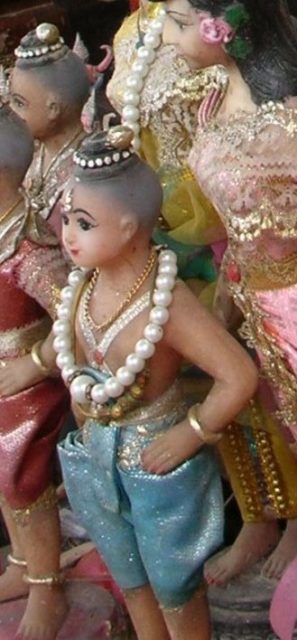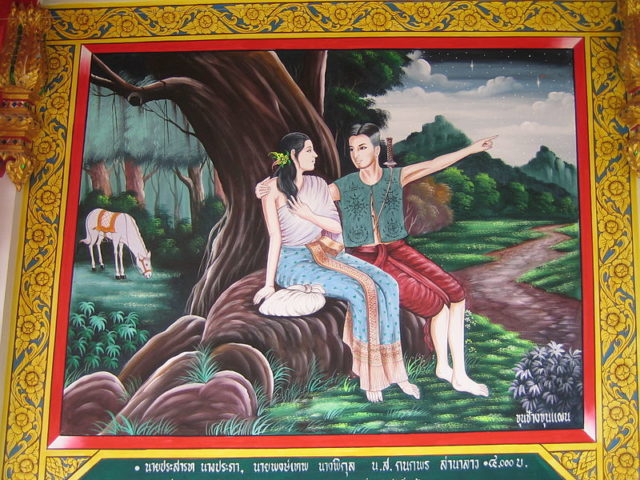Recently, the reports of a Thai doll craze are featured at the end of news hours, a spot typically reserved for pop culture or announcements of the special birthdays.
Yet, as strange as it is to think, people buy additional plane seats for their dolls -this new doll fad is only the latest in a centuries-old tradition; one that actually has a gruesome past.
Luk thep Dolls

Today dolls are usually known as luk thep, which mean child angels.
These lifelike toys are thought to have some kind of supernatural powers, andare commonly blessed in a ceremony by a Buddhist monk.
This is similar to the ceremony that is held for blessing amulets, and very popular in the country of Thailand.
It is thought that the dolls host wandering spirits who were invited to inhabit and animate the doll with a soul.
If this doll is treated well, it is said that it will bring good fortune to the owner, though if it is ignored the doll will appear like a naughty child and play tricks on you.
Most importantly, the small angel is supposed to protect the new family from evil spirits that are around.
A Child Protector
Fear of ghosts and superstition are extremely common in Thailand -before the arrival of the luk thep the Thais would come to the Kuman Thong for their protection.
The belief of a child protector actually dates back many centuries to the tale of Khun Chang Khun Phaen and thiss was a story of a solider that lived in the Ayutthaya era. As the story goes, Khun Phaen was a high ranking soldier.

He married the daughter of a powerful sorcerer, but shortly into the marriage, the sorcerer and Khun Phaen had a huge fight.
The sorcerer was enraged and tried pressuring his daughter into poisoning Khun Phaen, but she was not able to go through with it and died instead.
Khun Phaen was so angry that he ripped the stillborn fetus out of his wife’s womb and cast it into the fire of a temple.
After the ceremony, the child turned into a ghost that was able to speak with him and acted as a guardian spirit.

Thai Necromancy
This tale features elements of Thai necromancy, a black magic that was practiced by witch doctors. The ritual that created the Kuman Thong guardian spirit had involved preparing and chanting over the fetus that died while it was still in the mother’s womb.
As stated by the ancient manuscripts, the tiny corpse was to be taken to a cemetery where a fire was built up. Before the sun rose, the fetus was positioned on a grill over a fire and roasted until dry.
This was while the witch chanted incantations to be able to summon the Kuman Thong.
Once the drying was finished, the fetus was painted with a special liquid that was made out of shellac known as Ya Lakand – they were then covered in gold leaf.
This is the root of the name Kuman Thong, which actually means the Golden Little Boy – preferably, the model of a person was soaked in Nam Man Phrai.
This was a powerful oil that was part of Thai occult customs.
This oil was obtained by placing a candle underneath the chin of a woman who passed while being pregnant, or a person who had died an unnatural, violent death. Kuman Thongs and Nam Man Phrai were created out of dead babies and are currently illegal.
Every now and then, a story will come up about a stockpile of dead fetuses that were detected by airport security guards or had been stolen from abortion clinics to be blessed at temples.
Today, several Kuman Thong are not created from actual human fetuses and as an alternative, they are tiny dolls or statues of a smiling boy in custom Ayutthaya clothing.
Kuman Thong dolls were related to the hyper-realistic luk thep dolls, they required drink and food daily. Like the majority of children, they were thought to have preferred sweets like candies and cookies.
For drinks, the dolls, like several figures that were worshiped in Thailand, would almost exclusively want Nam Daeng, which translates as red water.
This was created by using bright red artificial food coloring and the flavoring of the native sala fruit and if the customary Nam Daeng can’t be obtained, red Fanta was the next best thing.
Some believe the idols preference for the red beverage comes from the ancient custom of offering the spirits animal blood.
The luk thep and Kuman Thong dolls also demanded affection and were offered toys, much like an actual child would. Otherwise, they would terrorize the neglectful family.
